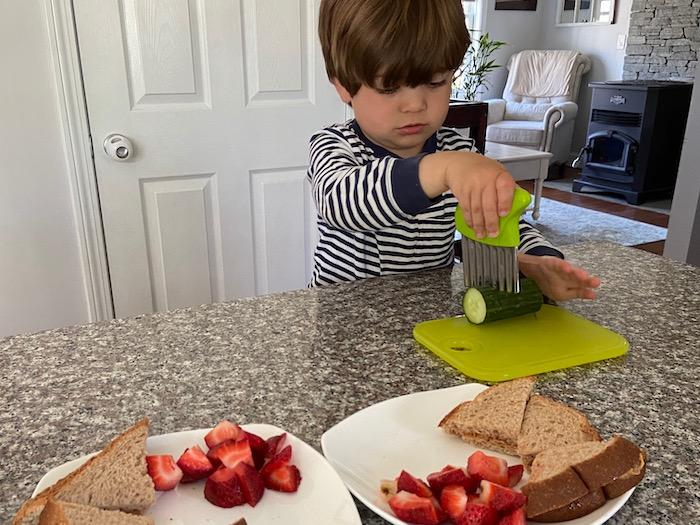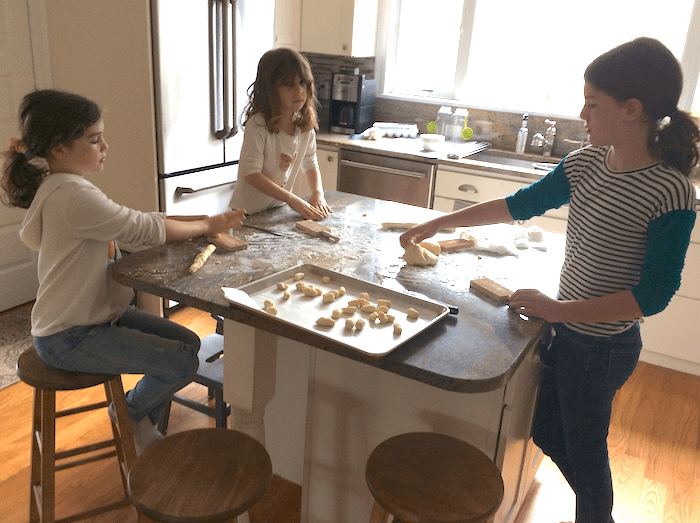One of the many joyful aspects of a Montessori environment is food preparation. Learning how to prepare one’s own food is a critical life skill, and it has always been a part of Montessori learning. While toddlers learn to sit together and gracefully serve and share food, at age three our primary students begin to prepare it for themselves. Even in classrooms for older students, guides find ways to work in this important practice for children. There are plenty of ways you can support your child’s developing skills at home.
Start Small: Give Mini-Lessons
We treat food prep the same as we would any other subject. We teach small skills in isolation and with intention. Parents can work the same approach into their kitchens at home. Simply demonstrate what to do, then give your child a chance to try it for themselves. The following are some ideas to get you started:
- Cutting and Slicing: We don’t recommend giving your four-year-old your sharpest knife, but there are lots of good options to teach this skill safely. Whether you choose to use a butter knife or try a kid-friendly wavy chopper, learning to cut and slice are good first skills to teach. Think cucumbers, celery, boiled eggs, bananas...whatever they like to eat is a great place to start!
- Spreading: This one is pretty self-explanatory. Utilize a variety of spreads and surfaces, like cream cheese on bagels, nut butter on celery, butter on toast, or hummus on a cracker.
- Mixing: Stirring and blending are natural next steps. Children can learn to whisk eggs, make instant pudding, or help combine ingredients for a meal you're putting together.
- Using Various Tools: Once they’ve mastered the above mentioned skills, your child is ready to learn how to use other tools, including a melon baller, vegetable peeler, cheese grater, rubber spatula, potato masher, juicer, tongs, or an ice cream scoop. Introducing a wide variety of tools will keep them engaged and interested.
- Using Heat: Once you feel your child is ready you can begin to introduce recipes that require heat. Start simple: teach them how to make their own toast. You can then move on to whatever works for your family. They may enjoy making pancakes, rice, tea, or popcorn.
- Measuring: While measuring is critical to following recipes and learning to cook, it’s also an excellent way to bring math into the kitchen. They sky’s the limit on this one. You could teach your child to follow family recipes or discover new ones together!

Provide Opportunities For Practice
Food preparation shouldn’t be a one-time experience. The long term goal is to encourage children to gain skills independently while building up their interest and confidence. To do this, we must give kids ongoing opportunities to get into the kitchen and make food for themselves and for others.
Find ways to make this work for you. Once your child has a few skills mastered, perhaps they can be in charge of preparing their own daily snacks. As they get a bit older, they can take on the responsibility of making their own lunch, or even someday preparing dinner for their family!
Encourage Independence and Exploration
It can be tempting to come up with a plan and force our children to stick to it. It is helpful to remember, however, that “follow the child” is our motto, and for good reason. Perhaps you planned to have your child learn to chop carrots while helping you prepare dinner, but they are suddenly really into apples. Take cues from their interests and the experience will be far more rewarding for them (and for you, too!).
Whenever possible, step back and let them take over. The key is teaching them a skill so that they may master it themselves. As children get older, let them explore cookbooks and even begin to create recipes of their own.

Teach About Nutrition
While there’s certainly nothing wrong with teaching your child how to whip up a batch of cookies, food prep at home is a great way to teach your child about healthy eating. As you work with various ingredients it can be nice to talk about their benefits. We all enjoy the pleasure derived from eating delicious food, but knowing on a scientific level how different foods are beneficial to our bodies adds an extra layer of interest.
Give Trust...and Make Room For Errors
Within reasonable safety parameters, try to step back and let your child make mistakes. Mistakes are a critical part of learning, and we need to let them happen (even if that means a little more work). There will be spills. There will be smudgy faces. There will be burnt baked goods. There may even be a splatter or two on the wall. Let it happen.
This is a nice time for us to recognize that food prep is part of the Montessori practical life curriculum. Another important part of practical life is cleaning. They may need help at first, but you can teach them to wipe up those messes!
We hope this post will inspire you to get your child into the kitchen more, and we know they will love it! Enjoy the successes, embrace the messes, and have fun eating together.
